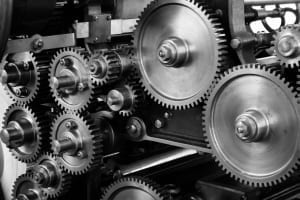3 Reasons Why a Ball Screw May Fail: Here’s What to Do If You Encounter This
 Premature or unanticipated ball screw failure can be extremely frustrating, especially when it causes machine downtime. Thankfully, most ball screws can be repaired, and those that can’t be repaired or refurbished can be reverse engineered to meet the machine’s exact specifications. Before going into these repair options, let’s take a look at three of the most common reasons why a ball screw may fail.
Premature or unanticipated ball screw failure can be extremely frustrating, especially when it causes machine downtime. Thankfully, most ball screws can be repaired, and those that can’t be repaired or refurbished can be reverse engineered to meet the machine’s exact specifications. Before going into these repair options, let’s take a look at three of the most common reasons why a ball screw may fail.
Common Reasons for Ball Screw Failure
There are many reasons ball screws may fail prematurely, ranging from improper storage to overloading and even mismatching of leads between ball screws and ball nuts. Three reasons stand out among the crowd due to their frequency, so machine operators and owners should keep an eye out for these common problems.
Lack of Lubrication
Machine lubrication systems must be properly maintained using the correct type of lubricant. This helps to dissipate heat, reducing component wear. Insufficient lubrication is one of the most common reasons for ball screw failure, so machine operators should pay careful attention to this essential maintenance task. If the damage has already been done, machine owners can visit dynatect.com to get the help they need.
Eccentric Loading
Ball nuts and ball screws must be properly aligned to avoid eccentric loading, or sideloading. The ball screw assembly is only equipped to handle axial loading, so eccentric loading can cause the ball bearings to wear flat or break out of their return tubes. Eccentric loading can also create problems with overloading.
Excessive Speed
All ball screw assemblies are manufactured to withstand only a certain speed of operation, known as the critical speed. Exceeding this speed can cause the screw to vibrate or whip, causing misalignment and reducing ball screw longevity. Ball screw surface speeds above 8,000 inches per minute will almost always result in reduced rated life.
What to Do About Ball Screw Failure
The first thing to do is to call a specialized repair service. Some services offer 24-hour rush repairs, which may be the best option for those who need to get their machines up and running quickly. Otherwise, look for a company that offers quick turnarounds and economical replacement options.
In some cases, ball screw assemblies can’t be repaired. If it has sustained damage due to pitting or brinneling, the unit may need to be refurbished instead. The ball screw itself will need to be reground, and a new ball nut will be manufactured to fit the original assembly specifications.
Machine owners shouldn’t stop at repairing or refurbishing their ball screws and replacing them without first identifying and resolving the underlying problem. Lack of lubrication, eccentric loading, and excessive speed are all relatively easy problems to fix. If necessary, consult an engineer for help with correcting the problem. It will be worth the money since it will prevent the need for frequent repairs and costly premature replacements.
The Bottom Line
Ball screws have an impressively diverse set of precision applications, ranging from machine tooling to robotics, and beyond. These complex components are essential to the functioning of all machines that require linear actuation, so it’s important for machine owners to ensure that they are kept well-lubricated, clean, and properly aligned. When having a ball screw repaired, make sure to work with a reputable company that specializes in this niche field, and don’t shy away from hiring an engineer to help identify the underlying problem.













Leave a Reply
Want to join the discussion?Feel free to contribute!